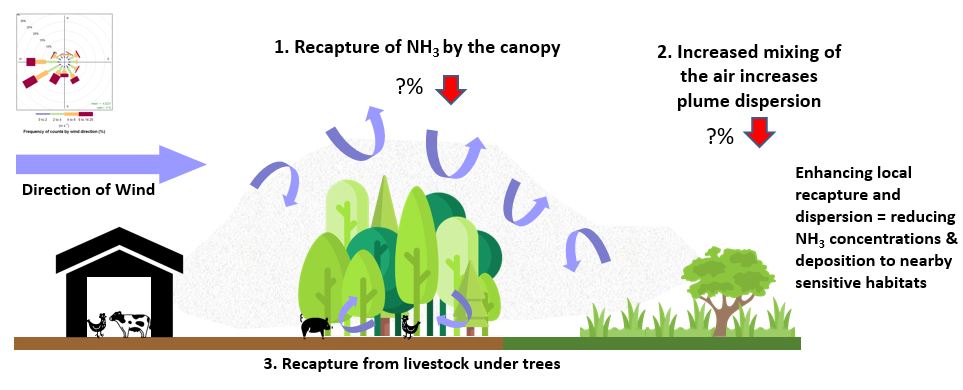Trees and other ‘green infrastructure’ have been researched over the years with a focus on the urban environment and human health impacts from pollutants such as nitrogen oxides (NOx) and particulates (ref). Ammonia is a highly soluble and reactive gas containing nitrogen (N) which can readily deposit (called N deposition) from the atmosphere to vegetation and the soil. N deposition to sensitive habitats damage plant communities that have evolved on nutrient-poor soils (e.g. bogs, heathlands and some woodlands). There is a combined effect (Figure 1) of treebelts on ammonia concentrations through:
- capture of the plume by the canopy by deposition to the leaf surface and uptake through the stomata and
- increased mixing and dilution of the plume though the creation of eddies and turbulence from the treebelt.

Treebelt and capture and dispersion
The fraction of ammonia recaptured varies depending on the source strength, meteorological and surface conditions. Studies by Fowler et al. (1998), showed that between 3% and 8% of NH3 emissions from a livestock building were deposited in woodland within 300m of the source. Further work by Bealey et al. (2014), focussed on a range of planting strategies showed that woodlands designed to recapture NH3 from a range of livestock sources (at around 10-20 metres) could recapture a substantially greater fraction of NH3 emissions, up to 20%. In addition rough landscape features such as treebelts can also help disperse ammonia, reducing concentrations near sources and therefore decreasing the most extreme impacts on nearby sensitive receptor ecosystems.
The aim of the Ammonia Reduction from Trees project was to provide new scientific evidence on tree planting for reducing the impact of ammonia emissions from farming in order to inform better advice and support to farmers on ammonia mitigation and guidance. The work was organised into three work packages which were:
- WP1: collate and analyse emission and wind statistical datasets to provide a targeted approach to planting treebelts to protect sensitive habitats in the UK;
- WP2: to measure and test the effectiveness of treebelts in mitigating ammonia concentrations across a treebelt at 5 case study farms;
- WP3: to gather information and undertake farmer surveys to provide feedback on the practicalities and limitations of tree planting to mitigate ammonia emissions.
Workshop outputs
14 January 2022 13.30 – 15.00 Webinar: Overview of the Ammonia Reduction by Trees project
This webinar introduced the project in the context of air quality and tree planting on farms and provided a summary of key findings of the Ammonia Reduction by Trees (ART) project.
ART full - webinar 14 January 2022
